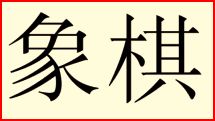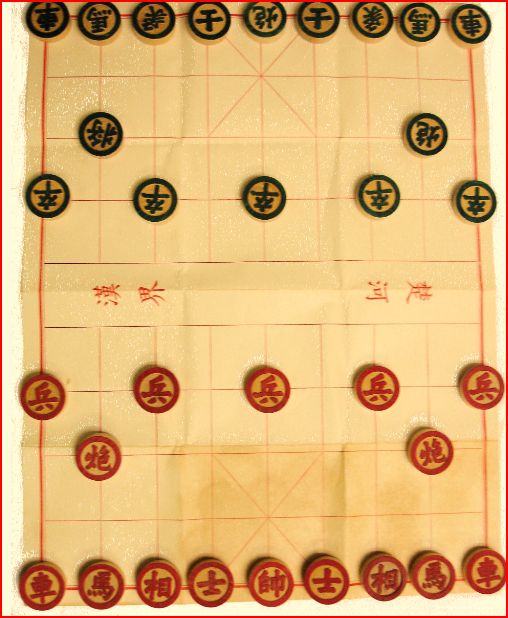Chinese Chess
Xiangqi, or Chinese Chess, is an extremely popular game in the Eastern Hemisphere. It is currently played by millions (or tens of millions) in China's mainland, Taiwan, Thailand, Singapore, Vietnam, Hong Kong and other Asian countries. Xiangqi has remained in its present form for centuries.
The name Xiangqi has an interesting origin. Of China's four traditional arts -- qin (music), hua (brush painting), shu (calligraphy) and qi (strategy games) -- the latter term, qi, provides the final syllable of Xiangqi .
History
Chinese chess has a long history. Its origin has not been confirmed yet. But judging by its rules, we can conclude that the origin of Chinese chess was closely related to military strategists in ancient China.
During the Spring and Autumn Period and the Warring States Period, wars were fought for years running. A new chess game was patterned after the array of troops. This was the earliest form of Chinese chess.
During the Wei, Jin and Northern and Southern Dynasties, a kind of chess game was popular among the people. It laid a foundation for the finalized pattern of the Chinese chess.
In ancient times, the Chinese chess was always enjoyed by both highbrows and lowbrows.
During the reign of Suzong of the Tang Dynasty, Prime Minister Niu Sengru wrote a fake story about chess. That occurred during the Baoying period, so it was named Baoying chess. Baoying chess had six pieces. He wrote about the rules of the chess. Baoying chess produced a significant influence on the chess in subsequent years.
Three forms of chess took shape after the Song Dynasty. One of them consisted of 32 pieces. They were played on a chessboard with 9 vertical lines and 9 horizontal lines. Popular in those days was a chessboard without a river borderline. The Chu River and Han Borderline were added later. This form has lasted to this day.
With the economic and cultural development during the Qing Dynasty, the Chinese chess entered a new stage. Many different schools of chess circles and chess players came into prominence. With the popularization of the Chinese chess, many books and manuals on the techniques of playing chess were published. They played an important role in popularizing the Chinese chess and improving the techniques of playing in modern times.
Pieces
Each player has the following pieces:
2 Rooks (R) (or chariots)
2 Knights (N) (or horses)
2 Elephants (M) (or bishops or ministers)
2 Mandarins (G) (or advisors or assistants or guards)
1 King (K) (or generals)
2 Cannons (C)
5 Pawns (P) (or soldiers)
Rooks
The Rook moves as an orthodox Rook.
Knights (Mao)
The Knight moves one point orthogonally followed by one point outward-diagonally. It may not leap over occupied points.
Elephants
The Elephant moves exactly two points diagonally. It may not leap over occupied points. Also, Elephants are confined to their home side of the river. Due to these limitations, the Elephant can see only seven points of the board. [The symbols on red and black Elephants differ, but their moves are the same.]
Mandarins
The Mandarin (or Guard) moves one point diagonally. It may never leave the palace. [The symbols on red and black Mandrians differ, but their moves are the same.]
King or General
The King moves as an orthodox King, but cannot move diagonally. It may never leave the palace. [The symbols on red and black Kings differ, but their moves are the same.]
The two Kings cannot face each other on an open file. For example, a red King on e1 and a black King on e9, with no piece on the e-file between them, is an illegal position. If either King sits exposed on an open file, the other King may not move to occupy that file.
Cannons (Pao)
The Cannon moves differently when it moves to capture than when it moves passively.
The Cannon moves passively as an orthodox Rook
The Cannon moves to capture as an orthodox Rook which is required to hop over a single screen.
In other words, Cannons capture by hoping over a second piece in order to capture a third piece. For example, a Cannon on a1 can take a piece on f1 when exactly one of the points b1, c1, d1, or e1 is occupied by a piece of either color. Cannons only capture when hoping and only hop when capturing. They may never hop over more than one piece in a given move.
Pawns
Unlike orthodox Pawns, the Xiangqi Pawn's passive move and capture move are always the same. A starting Pawn moves one point straight-forward. A Pawn crossing the river promotes, keeping its old move and gaining a new move -- a one-point step to either horizontal. Pawns do not promote on the last rank, where they can move only left or right.[The symbols on red and black Pawns differ, but their moves are the same.]
Rules
a) The object of the game is to checkmate or stalemate the opponent. This is accomplished by:
Placing the opponent in check so that he has no legal move to get out of the check.
Stalemating your opponent so that he has no legal move (when you stalemate your opponent, you win--it is not a draw as in chess).
b) Red usually moves first.
c) You cannot check your opponent indefinitely by moving the same piece to the same squares (resulting in perpetual check and a draw in chess). You cannot put the opponent in check more than 3 times in a row with the same piece without either side moving any other piece.
d) Similar to the rule above, you cannot indefinitely "chase" an opposing piece from one square to another if your opponent has no other way to avoid losing the piece. If you move a rook to e5 threatening a cannon on e6, and your opponent's only move to avoid capture is to move the cannon to f6, then you cannot keep chasing it from e6 to f6 by moving from e5 to f5 indefinitely. The idea of this rule and the rule above is to avoid perpetual check draws. Some of these situations can be complicated but usually the person who is initiating the perpetual move loop must break it off.
e) The two kings cannot face each other on the same file. If red's king is on e1 and black's king is on e9 and there are no pieces directly between them on the e-file, then that is an illegal position. If black's king is the only piece on the f-file, then red's king on the e-file cannot move to the file.
f) When neither side can capture the opposing king, the game is a draw[img]

[/img][img]

[/img]

